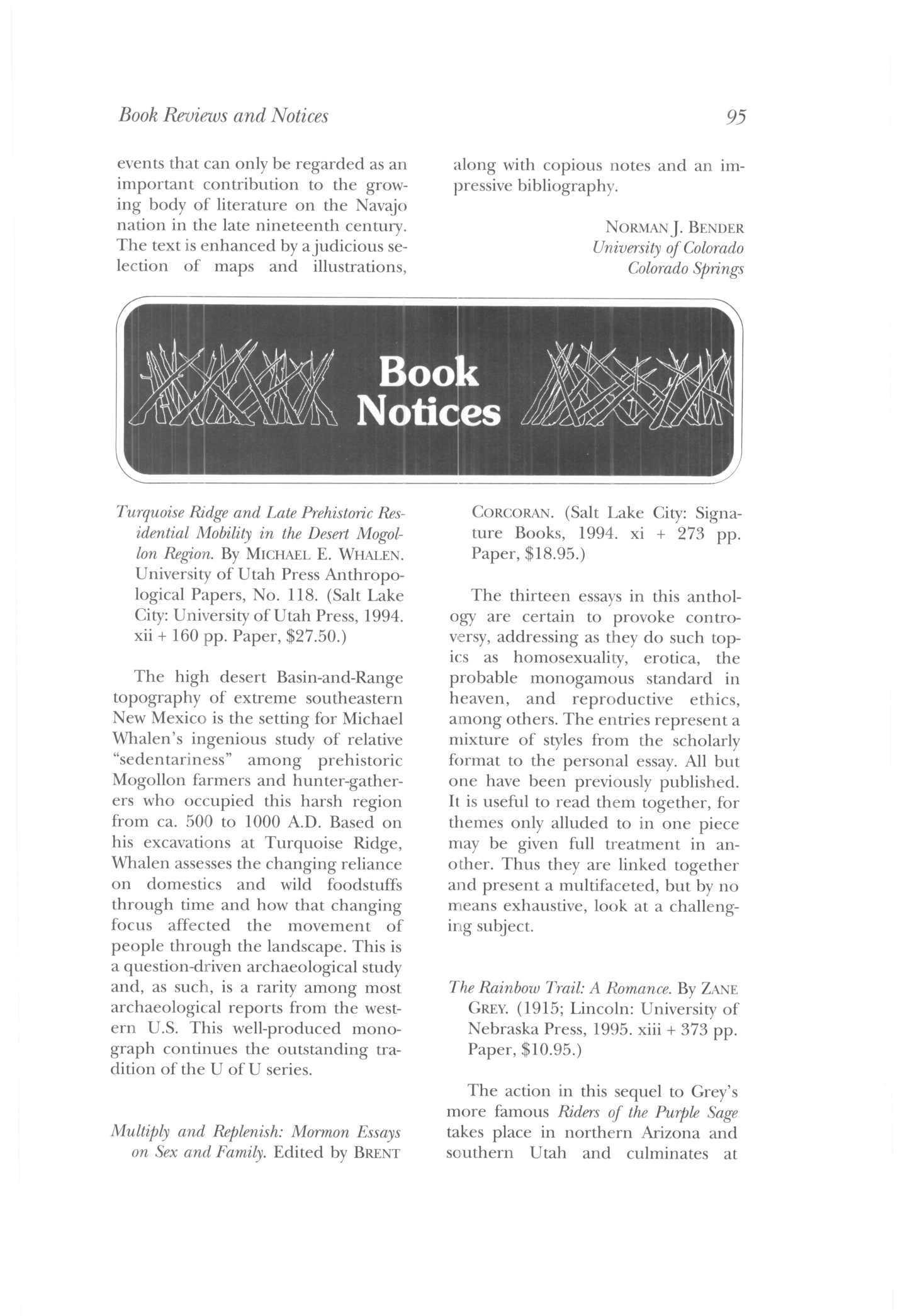
3 minute read
Book Notices
Turquoise Ridge and Late Prehistoric Residential Mobility in the Desert Mogollon Region.
By MICHAEL E WHALEN University of Utah Press Anthropological Papers, No 118 (Salt Lake City:University of Utah Press, 1994. xii + 160 pp Paper, $27.50.)
The high desert Basin-and-Range topography of extreme southeastern New Mexico is the setting for Michael Whalen's ingenious study of relative "sedentariness" among prehistoric Mogollon farmers and hunter-gatherers who occupied this harsh region from ca. 500 to 1000 AD. Based on his excavations at Turquoise Ridge, Whalen assesses the changing reliance on domestics and wild foodstuffs through time and how that changing focus affected the movement of people through the landscape This is a question-driven archaeological study and, as such, is a rarity among most archaeological reports from the western U.S This well-produced monograph continues the outstanding tradition of the U of U series
Multiply and Replenish: Mormon Essays on Sex and Family.
Edited by BRENT CORCORAN (Salt Lake City: Signature Books, 1994 xi + 273 pp Paper, $18.95.)
The thirteen essays in this anthology are certain to provoke controversy, addressing as they do such topics as homosexuality, erotica, the probable monogamous standard in heaven, and reproductive ethics, among others. The entries represent a mixture of styles from the scholarly format to the personal essay. All but one have been previously published It is useful to read them together, for themes only alluded to in one piece may be given full treatment in another Thus they are linked together and present a multifaceted, but by no means exhaustive, look at a challenging subject
The Rainbow Trail: A Romance.
ByZANE GREY. (1915; Lincoln: University of Nebraska Press, 1995 xiii +373 pp Paper, $10.95.)
The action in this sequel to Grey's more famous Riders of the Purple Sage takes place in northern Arizona and southern Utah and culminates at Rainbow Bridge, which Grey first visited in 1913 after having written the earlier book. Typical of Grey's best work, which continued through the mid-1920s, The Rainbow Trail features not only dramatic action and scenery but also his reflections on the effects of white traders and missionaries on Navajo life A new introduction by Grey's son Loren effectively establishes the book's literary and cultural context
Good Years for the Buzzards.
By JOHN DUNCKLEE. (Tucson: University of Arizona Press, 1994. xi + 167 pp. $24.95.)
Fascinated as a child by a rodeo at Madison Square Garden,John Duncklee refused to follow his father's plan for him to attend an IvyLeague school and enter a business in Manhattan. Instead, Duncklee worked his way through the University of Arizona as a horse wrangler and in the 1950s leased a southern Arizona cattle ranch during the Southwest's worst drought in 400 years. Through a combination of numbing hard work, much ingenuity, and a little luck, he made a success of it His memoir is both entertaining and thought-provoking as he moves from his experiences as a greenhorn to his mature reflection on the fragile desert environment
Myths and Legends of California and the Old Southwest.
Compiled and edited by KATHARINE BERRY JUDSON (Lincoln: University of Nebraska Press, 1994 x + 193 pp Paper, $8.95.)
This is a reprint of Judson's 1912 compilation with an introduction by Peter Iverson Many of the tales were taken from the pioneering work of ethnologists associated with the Smithsonian Institution or other agencies.Judson's contribution was to make them available to a larger audience interested in Native American stories. Many of the tales are creation or origin myths or feature that ubiquitous character coyote or some other animal.







